人教版八年级英语下册unit4说课稿
八下英语Unit4说课稿
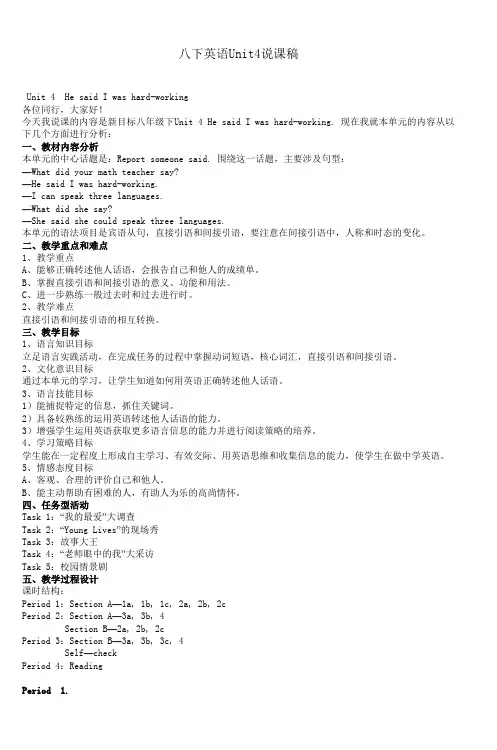
八下英语Unit4说课稿Unit 4 He said I was hard-working各位同行,大家好!今天我说课的内容是新目标八年级下Unit 4 He said I was hard-working. 现在我就本单元的内容从以下几个方面进行分析:一、教材内容分析本单元的中心话题是:Report someone said. 围绕这一话题,主要涉及句型:—What did your math teacher say?—He said I was hard-working.—I can speak three languages.—What did she say?—She said she could speak three languages.本单元的语法项目是宾语从句,直接引语和间接引语,要注意在间接引语中,人称和时态的变化。
二、教学重点和难点1、教学重点A、能够正确转述他人话语,会报告自己和他人的成绩单。
B、掌握直接引语和间接引语的意义、功能和用法。
C、进一步熟练一般过去时和过去进行时。
2、教学难点直接引语和间接引语的相互转换。
三、教学目标1、语言知识目标立足语言实践活动,在完成任务的过程中掌握动词短语,核心词汇,直接引语和间接引语。
2、文化意识目标通过本单元的学习,让学生知道如何用英语正确转述他人话语。
3、语言技能目标1)能捕捉特定的信息,抓住关键词。
2)具备较熟练的运用英语转述他人话语的能力。
3)增强学生运用英语获取更多语言信息的能力并进行阅读策略的培养。
4、学习策略目标学生能在一定程度上形成自主学习、有效交际、用英语思维和收集信息的能力,使学生在做中学英语。
5、情感态度目标A、客观、合理的评价自己和他人。
B、能主动帮助有困难的人,有助人为乐的高尚情怀。
四、任务型活动Task 1:“我的最爱”大调查Task 2:“Young Lives”的现场秀Task 3:故事大王Task 4:“老师眼中的我”大采访Task 5:校园情景剧五、教学过程设计课时结构:Period 1:Section A—1a, 1b, 1c, 2a, 2b, 2cPeriod 2:Section A—3a, 3b, 4Section B—2a, 2b, 2cPeriod 3:Section B—3a, 3b, 3c, 4Self—checkPeriod 4:ReadingPeriod 1.Step 1. Warming upRead the chant.I am a girl, I am a girl.She said she was a girl.I can sing, I can sing.He said he could sing.I will be a doctor, I will be a doctor.He said he would be a doctor.通过琅琅上口的chant,让学生感知本单元的学习重点。
人教版八年级下 4单元说课稿

Unit 4 He said I was hard-working.Section B(3a—4)说课稿安仁初中娄丽花Unit 4 He said I was hard-working.说课稿Section B 3a—4说教材本节课是选自人教版新目标英语八年级下册第四单元“Unit 4 He said I was hard-working.”Section B 3a-4部分中的阅读与写作课,本节课主要围绕学生很熟悉的Report card (成绩单)这个话题,运用间接引语转述3a中Alan的成绩单内容,并运用所学的语言实现能力的迁移,能够向他人转述自己成绩单中的内容。
以此来培养学生的自我评价意识和能力,改进不足,争取全面发展。
本节课情境贴近生活,每次考完试,家长们都会询问成绩,孩子们则向家长汇报他们各科的情况,因而该语法功能非常实用,学生也乐学。
通过学生们的自主与合作学习,体现了以学生为主体的教育理念。
说学习目标1.知识目标:掌握文章中一些表个人评价的词汇hard-working(勤奋的), can do better(有待提高), do well in, be good at以及重要词组report card ,get nervous ,have a hard time ,another disappointing news ,Luckily 等。
2.能力目标:用本节课的重点词汇能转述Alan的成绩单中的内容,并能够实现能力的迁移,学会向他人转述自己的成绩单中的内容。
3.情感目标:培养学生的自我评价意识和能力,改进不足,争取全面发展。
说重点、难点重点:用本节课的重点词汇转述成绩单中的内容。
难点:在向他人转述成绩单的过程中,人称与时态的转换是难点。
说学情、说教法学生到了初二有了明显的两极分化的现象,好学生单词和语言表达能力、听力都好,综合能力强;中等层次的学生单词掌握较好,语言表达能力欠缺;学困生无论单词、听力、语法、语言表达能力都很弱,即学生的语言表达能力尤其是阅读、说与写作的能力普遍较弱,并且学生的学习方法欠佳。
新目标人教版八年级下册英语第四单元说课稿教育文档
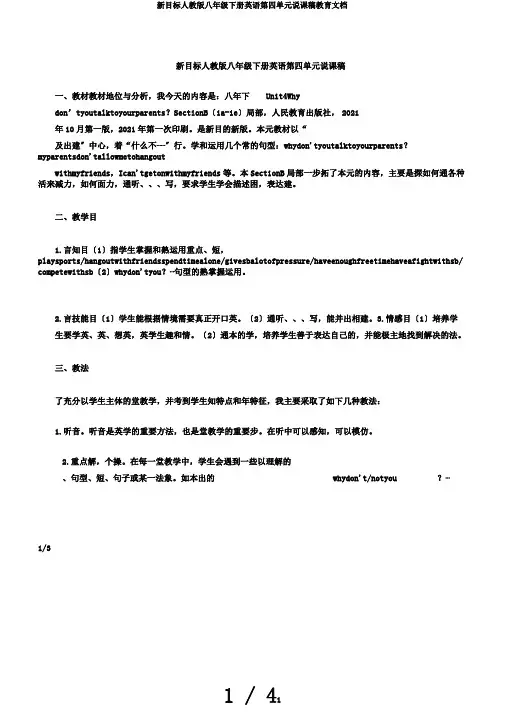
新目标人教版八年级下册英语第四单元说课稿一、教材教材地位与分析,我今天的内容是:八年下Unit4Whydon’tyoutalktoyourparents?SectionB〔1a-1e〕局部,人民教育出版社,2021年10月第一版,2021年第一次印刷。
是新目的新版。
本元教材以“及出建〞中心,着“什么不⋯⋯〞行。
学和运用几个常的句型:whydon'tyoutalktoyourparents?myparentsdon'tallowmetohangoutwithmyfriends,Ican'tgetonwithmyfriends等。
本SectionB局部一步拓了本元的内容,主要是探如何通各种活来减力,如何面力,通听、、、写,要求学生学会描述困,表达建。
二、教学目1.言知目〔1〕指学生掌握和熟运用重点、短,playsports/hangoutwithfriendsspendtimealone/givesbalotofpressure/haveenoughfreetimehaveafightwithsb/ competewithsb〔2〕whydon'tyou?⋯句型的熟掌握运用。
2.言技能目〔1〕学生能根据情境需要真正开口英。
〔2〕通听、、、写,能并出相建。
3.情感目〔1〕培养学生要学英、英、想英,英学生趣和情。
〔2〕通本的学,培养学生善于表达自己的,并能极主地找到解决的法。
三、教法了充分以学生主体的堂教学,并考到学生知特点和年特征,我主要采取了如下几种教法:1.听音。
听音是英学的重要方法,也是堂教学的重要步。
在听中可以感知,可以模仿。
2.重点解,个操。
在每一堂教学中,学生会遇到一些以理解的、句型、短、句子或某一法象。
如本出的whydon't/notyou ?⋯1/3句型的用法等都需要个别解释甚至创设语言情境进行操练和举例,以扫除自由交际过程中的障碍,为语言的进一步学习奠定根底。
人教版八年级英语下册Unit4SectionA说课稿
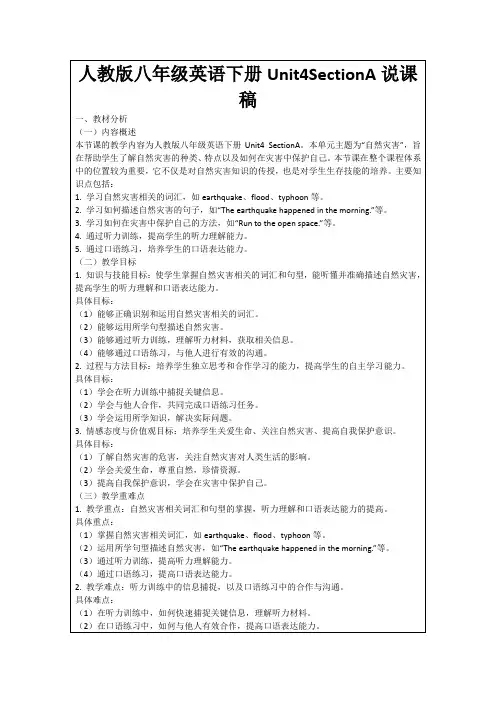
(3)通过听力训练,提高听力理解能力。
(4)通过口语练习,提高口语表达能力。
2.教学难点:听力训练中的信息捕捉,以及口语练习中的合作与沟通。
具体难点:
(1)在听力训练中,如何快速捕捉关键信息,理解听力材料。
学生在学习本节课之前,可能已经具备一些前置知识或技能,如基础的英语词汇量和简单的听力理解能力。然而,以下学习障碍可能存在:
前置知识不足:部分学生对自然灾害相关词汇的掌握可能不足,影响对听力材料和口语练习的理解。
学习方法不当:学生在听力训练中可能缺乏有效的信息捕捉策略,导致听力理解困难。
学习态度问题:学生对英语学习的态度可能影响学习效果,缺乏积极性的学生可能在口语练习中参与度不高。
4.口语练习:学生两两配对,使用所学词汇和句型进行对话练习。
(四)总结反馈
在总结反馈阶段,我将采取以下措施引导学生自我评价并提供有效的反馈和建议:
1.鼓励学生自我反思:让学生思考自己在课堂上的表现,包括学习态度、参与程度和知识掌握情况。
2.提供具体反馈:针对学生的表现,给出具体的表扬和建议,帮助他们认识到自己的优点和需要改进的地方。
(三)巩固练习
为了帮助学生巩固所学知识并提升应用能力,我将设计以下巩固练习和实践活动:
1.小组讨论:学生分组讨论如何在自然灾害中保护自己和他人,鼓励他们使用所学词汇和句型进行交流。
2.角色扮演:学生扮演不同的角色,如救援人员、受灾群众等,进行情境模拟,练习使用所学知识进行对话。
3.听力任务:播放一段关于自然灾害的听力材料,让学生完成相关任务,如填空、回答问题等。
认知水平:学生的认知水平逐渐提高,能够理解抽象的概念,具备一定的逻辑思维能力,但在复杂问题的解决上仍需引导。
人教新目标版英语八下Unit4《Whydon’tyoutalktoyourparents》说课稿
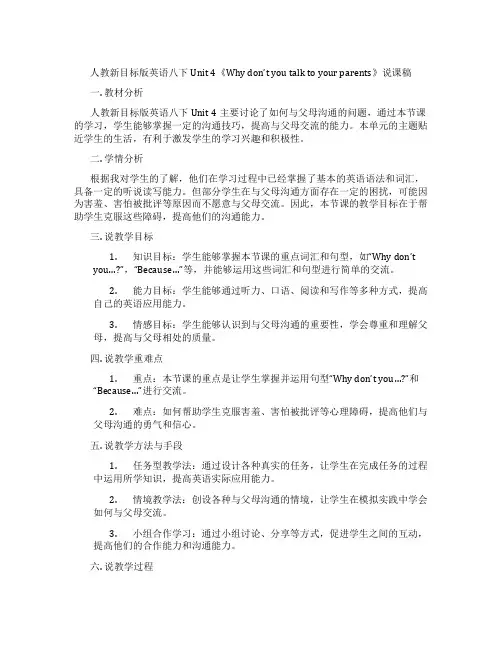
人教新目标版英语八下Unit 4《Why don’t you talk to your parents》说课稿一. 教材分析人教新目标版英语八下Unit 4主要讨论了如何与父母沟通的问题,通过本节课的学习,学生能够掌握一定的沟通技巧,提高与父母交流的能力。
本单元的主题贴近学生的生活,有利于激发学生的学习兴趣和积极性。
二. 学情分析根据我对学生的了解,他们在学习过程中已经掌握了基本的英语语法和词汇,具备一定的听说读写能力。
但部分学生在与父母沟通方面存在一定的困扰,可能因为害羞、害怕被批评等原因而不愿意与父母交流。
因此,本节课的教学目标在于帮助学生克服这些障碍,提高他们的沟通能力。
三. 说教学目标1.知识目标:学生能够掌握本节课的重点词汇和句型,如“Why don’tyou…?”,“Because…”等,并能够运用这些词汇和句型进行简单的交流。
2.能力目标:学生能够通过听力、口语、阅读和写作等多种方式,提高自己的英语应用能力。
3.情感目标:学生能够认识到与父母沟通的重要性,学会尊重和理解父母,提高与父母相处的质量。
四. 说教学重难点1.重点:本节课的重点是让学生掌握并运用句型“Why don’t you…?”和“Because…”进行交流。
2.难点:如何帮助学生克服害羞、害怕被批评等心理障碍,提高他们与父母沟通的勇气和信心。
五. 说教学方法与手段1.任务型教学法:通过设计各种真实的任务,让学生在完成任务的过程中运用所学知识,提高英语实际应用能力。
2.情境教学法:创设各种与父母沟通的情境,让学生在模拟实践中学会如何与父母交流。
3.小组合作学习:通过小组讨论、分享等方式,促进学生之间的互动,提高他们的合作能力和沟通能力。
六. 说教学过程1.导入:通过一个关于父子间沟通的小故事,引发学生对与父母沟通的思考,激发他们的学习兴趣。
2.呈现:介绍本节课的主题,展示相关的词汇和句型,让学生初步感知和学习。
3.实践:设计各种与父母沟通的情境,让学生在模拟实践中运用所学知识。
人教新目标八年级英语下册Unit4Whydon'tyoutalktoyourparents说课稿
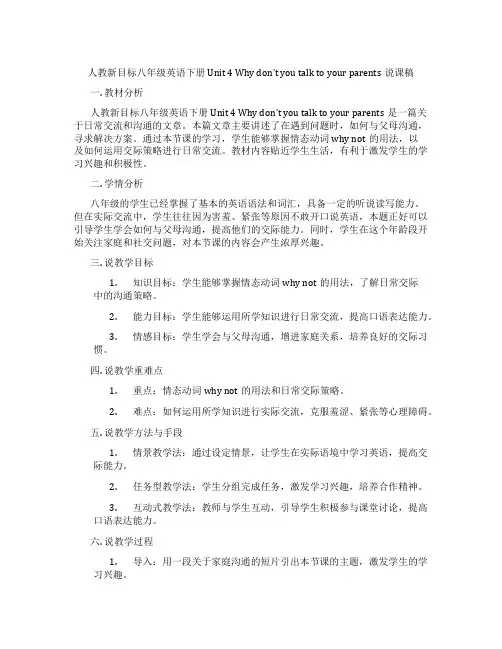
人教新目标八年级英语下册Unit 4 Why don’t you talk to your parents说课稿一. 教材分析人教新目标八年级英语下册Unit 4 Why don’t you talk to your parents是一篇关于日常交流和沟通的文章。
本篇文章主要讲述了在遇到问题时,如何与父母沟通,寻求解决方案。
通过本节课的学习,学生能够掌握情态动词why not的用法,以及如何运用交际策略进行日常交流。
教材内容贴近学生生活,有利于激发学生的学习兴趣和积极性。
二. 学情分析八年级的学生已经掌握了基本的英语语法和词汇,具备一定的听说读写能力。
但在实际交流中,学生往往因为害羞、紧张等原因不敢开口说英语,本题正好可以引导学生学会如何与父母沟通,提高他们的交际能力。
同时,学生在这个年龄段开始关注家庭和社交问题,对本节课的内容会产生浓厚兴趣。
三. 说教学目标1.知识目标:学生能够掌握情态动词why not的用法,了解日常交际中的沟通策略。
2.能力目标:学生能够运用所学知识进行日常交流,提高口语表达能力。
3.情感目标:学生学会与父母沟通,增进家庭关系,培养良好的交际习惯。
四. 说教学重难点1.重点:情态动词why not的用法和日常交际策略。
2.难点:如何运用所学知识进行实际交流,克服羞涩、紧张等心理障碍。
五. 说教学方法与手段1.情景教学法:通过设定情景,让学生在实际语境中学习英语,提高交际能力。
2.任务型教学法:学生分组完成任务,激发学习兴趣,培养合作精神。
3.互动式教学法:教师与学生互动,引导学生积极参与课堂讨论,提高口语表达能力。
六. 说教学过程1.导入:用一段关于家庭沟通的短片引出本节课的主题,激发学生的学习兴趣。
2.新课呈现:教师展示文章,引导学生关注文章标题和关键词,预测文章内容。
3.课堂讲解:教师讲解情态动词why not的用法和日常交际策略,让学生通过例句理解并掌握。
4.实践环节:学生分组进行角色扮演,运用所学知识进行实际交流,教师巡回指导。
初二unit4说课稿
初二unit4说课稿尊敬的各位老师、同事们,大家好!今天我要为大家说课的是初二英语Unit 4的内容。
这一单元的主题是“Do it yourself”,通过这个单元的学习,学生们将能够了解并掌握有关自助服务和独立完成任务的相关英语表达方式。
接下来,我将从教材分析、教学目标、教学重点与难点、教学方法、教学过程和评价方式六个方面进行详细的说课。
一、教材分析本单元位于初二英语教材的第四单元,共有五个部分。
第一部分是对话,通过两个学生之间的对话,引入了DIY的概念,并展示了如何在家庭中进行一些简单的DIY项目。
第二部分是语法,重点讲解了现在进行时的用法,特别是用来描述正在发生的动作。
第三部分是阅读,介绍了一位著名的DIY爱好者和他的项目。
第四部分是写作,要求学生写一篇关于他们自己DIY经历的短文。
最后一部分是听力,通过一段关于DIY的访谈,让学生了解不同的DIY项目和人们对此的看法。
二、教学目标1. 知识目标:学生能够理解并掌握现在进行时的构成和用法,能够听懂、会说、认读和书写与DIY相关的词汇。
2. 能力目标:学生能够在实际情境中运用所学语言知识,进行有关DIY话题的听说读写活动。
3. 情感态度与价值观目标:培养学生的自主学习能力和动手能力,激发学生对DIY的兴趣,鼓励他们在生活中尝试解决问题。
三、教学重点与难点1. 教学重点:现在进行时的用法,DIY相关词汇的掌握和运用。
2. 教学难点:如何让学生在真实或模拟的情境中,灵活运用现在进行时描述正在进行的动作或状态。
四、教学方法1. 任务型教学法:通过设计一系列的DIY任务,让学生在完成任务的过程中学习和使用英语。
2. 合作学习法:鼓励学生分组合作,共同讨论和完成DIY项目,培养他们的团队协作能力。
3. 情景教学法:创设真实的DIY情景,让学生在情境中学习和使用英语。
五、教学过程1. 导入(5分钟)- 通过展示一些DIY项目的图片,激发学生的兴趣,并引入话题。
八下unit4说课稿
八下unit4说课稿一、说教材本文是八年级下册Unit 4的教学内容,本单元围绕“课外活动”的主题展开,旨在让学生在学习英语的过程中,了解并掌握与课外活动相关的词汇、句型以及表达方式。
本文在本单元中的作用和地位非常重要,它是单元的核心部分,主要通过对话和阅读材料,让学生在实际语境中运用所学知识,提高他们的英语交际能力。
主要内容:1. 对话部分:以学生讨论课外活动为背景,引出各种课外活动的名称,如篮球、音乐、绘画等,同时学习如何用英语表达参加某项活动。
2. 阅读部分:介绍了一篇关于参加课外活动的重要性的文章,让学生了解课外活动对个人成长的积极作用。
本文通过丰富的语言素材,帮助学生拓展课外活动的知识面,激发他们对英语学习的兴趣,提高他们的综合素质。
二、说教学目标学习本课,学生需要达到以下教学目标:1. 知识目标:a. 掌握与课外活动相关的词汇和短语,如basketball, music club, art club 等。
b. 学会使用一般现在时描述参加某项活动。
c. 理解并运用阅读材料中的重点句子和表达方式。
2. 能力目标:a. 能够运用所学词汇和句型进行简单的对话交流,讨论课外活动。
b. 提高阅读理解能力,抓住文章主旨,理解课外活动的重要性。
3. 情感目标:a. 培养学生对课外活动的兴趣,鼓励他们积极参与。
b. 培养学生的团队合作精神,提高他们的综合素质。
三、说教学重难点1. 教学重点:a. 与课外活动相关的词汇和短语。
b. 一般现在时的用法。
c. 阅读理解能力的培养。
2. 教学难点:a. 词汇的发音和拼写。
b. 一般现在时的正确运用。
c. 阅读材料中长难句的理解。
在教学过程中,要注意突破重难点,通过多种教学手段和活动,帮助学生扎实掌握所学知识,提高他们的英语能力。
四、说教法为了有效实现教学目标,突破教学重难点,我采用了以下几种教学方法,并在教学过程中凸显以下亮点:1. 启发法:在引入新课内容时,我通过提问方式启发学生思考,如:“What do youusually do after school?”, “Do you think after-school activities are important?”等,激发学生的好奇心和求知欲,使他们积极参与到课堂讨论中。
人教新目标英语八年级下册unit4第六课时说课稿
在学习本节课之前,学生已经掌握了描述人物的基本词汇和一般现在时的用法。但可能存在的学习障碍有:1.词汇量有限,不能灵活运用不同词汇描述同一人物特征;2.对一般现在时的用法掌握不够熟练,容易混淆;3.听说能力较弱,特别是在面对实际语境时,可能存在紧张、焦虑情绪,影响交流效果。
(三)学习动机
作业的目的是巩固课堂所学知识,培养学生的自主学习能力和实际运用能力,同时加强家校合作,促进学生的全面发展。
五、板书设计与教学反思
(一)板书设计
我的板书设计将遵循清晰、简洁、层次分明的原则。板书布局分为三部分:左边列出本节课的主要词汇,中间展示重点句型和语法结构,右边则是课堂活动的提示和总结。主要内容将包括人物描述的关键词汇、一般现在时的结构以及重要的问答句型。
(二)教学目标
知识与技能目标:学生能够熟练运用本节课所学的词汇和句型,描述自己和朋友的外貌和性格;学生能够理解并运用一般现在时描述人物特征。
过程与方法目标:通过小组合作、角色扮演等教学活动,培养学生的听说能力和团队合作精神;通过课堂互动,提高学生的英语思维能力和表达能力。
情感态度与价值观目标:激发学生对英语学习的兴趣,培养他们积极向上的学习态度;引导学生学会尊重他人,善于发现他人的优点,培养良好的人际交往能力。
3.征询学生的意见和建议,了解他们的学习需求。
反思和改进措施包括:
1.根据学生的反馈,调整教学方法和策略;
2.对课堂活动进行优化,提高学生的参与度和互动性;
3.针对学生的个性化需求,设计更多有针对性的教学活动,提升教学效果。
(二)媒体资源
我将使用以下教具、多媒体资源和技术工具辅助教学:
1.电子白板:展示教学课件,呈现词汇、句型及课文内容,方便学生观看和学习;
八下四单元说课稿英语
八下四单元说课稿英语在准备八年级下册第四单元的英语说课稿时,我们需要确保内容覆盖了该单元的核心知识点、教学目标、教学方法、学生活动以及评估方式。
以下是一份可能的说课稿内容:# 教学目标1. 学生能够理解并运用本单元的重点词汇和短语。
2. 学生能够熟练掌握并运用本单元的语法结构。
3. 学生能够通过阅读和听力材料,提高对英语语境的理解能力。
4. 学生能够在口语和写作中有效运用本单元的语言知识。
# 教学内容本单元的主题为“Travel and Places”,涉及旅行和地点的相关知识。
重点词汇包括交通工具、地点、旅游活动等。
语法点包括一般过去时和现在完成时的使用。
# 教学方法1. 导入新课:通过展示世界各地的图片或视频,激发学生对旅行话题的兴趣。
2. 词汇教学:使用图片、实物或情境对话来教授新词汇。
3. 语法点讲解:通过例句和练习题来讲解语法点,确保学生理解并能正确使用。
4. 听力训练:播放与旅行相关的听力材料,训练学生的听力理解能力。
5. 口语练习:组织角色扮演或小组讨论,让学生在实际对话中运用所学知识。
6. 阅读指导:指导学生阅读有关旅行的文章或故事,提高阅读理解能力。
7. 写作训练:让学生写一篇关于旅行的短文或日记,练习写作技巧。
# 学生活动1. 词汇游戏:通过词汇接龙或拼写比赛来巩固新词汇。
2. 语法练习:完成语法练习题,加深对语法点的理解。
3. 听力练习:听录音并回答问题,提高听力技能。
4. 口语交流:与同伴进行角色扮演或讨论,练习口语表达。
5. 阅读理解:阅读材料并回答相关问题,提高阅读能力。
6. 写作任务:完成写作任务,如写一篇旅行日记或描述一个理想旅行。
# 评估方式1. 课堂参与度:观察学生在课堂上的参与情况和互动能力。
2. 作业完成情况:检查学生的作业,评估其对知识点的掌握程度。
3. 口语表达:通过口语练习和角色扮演,评估学生的口语能力。
4. 写作能力:通过写作任务,评估学生的写作技巧和语言运用能力。
- 1、下载文档前请自行甄别文档内容的完整性,平台不提供额外的编辑、内容补充、找答案等附加服务。
- 2、"仅部分预览"的文档,不可在线预览部分如存在完整性等问题,可反馈申请退款(可完整预览的文档不适用该条件!)。
- 3、如文档侵犯您的权益,请联系客服反馈,我们会尽快为您处理(人工客服工作时间:9:00-18:30)。
Unit 4 He said I was hard-working.Good morning, ladies and gentlemen, I am Lai xiumei. It’s my great ple asure to stand here to interpret my lesson. Today I am going to talk abo ut the first period in Section A of Unit 4 He said I was hard-working, whi ch is taken from Go for it, Book 4.My presentation consists of six parts: analysis of the teaching material, analysis of the students, teaching metho ds, guiding of studying ways, teaching procedures and teaching reflection s.I. Analysis of the teaching materiali)Status and functionThe topic of this unit is about telling a story. The first period serves as an introduction and a warming up. They will learn to talk about what a soap opera is and report what people said. The materials in talking are mostly from the daily life and are familiar to students, so they are very interested in it.A series of questions and a big picture are used to attracts students’ attention. And listening and pair-work are also used in this period.ii) Teaching aims and demands1. Knowledge ObjectsIn this lesson, Ss should master the new word “mad” and the phrase“ be mad at”. At the same time, they should know how to use the key structures in this unit.2. Ability ObjectsIn this lesson, I’ll mainly train the Ss listening and speaking abilities and deve lop the Ss’ abilities of communication by learning the useful structures.3. Moral ObjectsFrom this lesson, the Ss should learn how to work with others and help each other, how to express their own ideas during the communication.4.Teaching keys and difficultiesAccording to the teaching aims, I think the focus of this lesson is the new expressions and help the Ss to communicate with each other. The difficulty is to help the Ss make conversations freely .5.Teaching aidsA tape recorder and a computer for multimedia use.II.Analysis of the studentsThe Ss have learned English for one and a half years, they can express their thought and communicate with each other with English well. And all the Ss will be interested in the topic, which is related to their real life.. It’s helpful for our study of this lesson.III.Teaching methodsIn this lesson, I’ll mainly use the cooperating teaching method, and it will be used in the whole lesson. I think it’s helpful to develop the Ss’ thought. I’ll also use “situation communicating” method. It can provide enough listeningand speaking situations for Ss. I think good teaching methods are the keys to success.IV.Guide of studying waysIn order to guide the Ss better, develop the Ss’ abilities, in this lesson, the Ss will learn how to be a good language learner, and how to communicate with others. It will be very helpful for their learning in the future. I think good studying ways can help the Ss to be good language learners.V.Teaching proceduresStep1. Revision.First , have a dictation of Unit3.Purpose of my designing: I think it is important to review the knowledge we have learned.Step 2 PresentationAsk four students to stand in front of the class, and the teacher asks them the following questions as a reporter.1. What are you going to do when you grow up?2. What are you going to do next week?3. What are going to do after school?The students will give different answers, then ask a good student to report what they said.I am going to e a doctor.What did she say?----------She said she was going to be a doctor.I am going to have a party on Friday night.What did he say?-------He said he was going to have a party on Friday night.I am going to do my homework.What did she say ?------ She said she was going to do her homework.I am going home after school.What did she say?-----She said she was going home after school.Say In this unit we are going to learn to use words like to report what someone said. Purpose of my designing: This activity introduces some new vocabulary and provide oral practice using the target language. I think it is much easier for the Ss to learn if I present the key structures one by one and they can master the structures quickly by doing this.Step 3 Group-workStudents read the instructions. Then ask a student to read the four questions. And write the words on the books. Explain what soap opera is and encourage Ss to say some soap operas in English or in Chinese.Help Ss form small groups. Ss begin to talk about the questions. .E.g. What did Marcia say? She said she said she was having a surprise party for Lana on Friday night. Repeat the other pictures in the same way.And explain the meaning of “be mad at sb”( here it means “be angry with sb”) Purpose of my designing: This step is employed to make the Ss get the general idea of the dialogue as a whole one. At the same time let the Ss have a chance to practice their listening and spoken ability.Step4 Listening practiceListen and number the pictures in activity 1a.Task 1. Play the recording the first time. Students only listen.Task 2. Play the recording a second time. Students number the pictures. Then check the answers.Purpose of my designing: It gives Ss practice in understanding the target language in spoken conversations.Step5. Pair-work 1c1.Read the instructions.2.Ask the Ss to read the example in the sample dialogue. Let the Ss ask andanswer questions about each picture.3.Ask several pairs of students to say a question and answer to the class. Purpose of my designing: Task-based teaching method is used here to develop Ss’ ability of communication and also their ability of co-operation will be well trained.Step7.Homework1. Make up your own conversations.2. Write down the sentences in 1a.Purpose of my designing: Revision is so important that Ss should speak English as much as they as in class or after class. It is necessary for the Ss to do some extensive exercises after class to consolidate the knowledge they learned.Blackboard designUnit 4 He said I was hard-working.soap opera be mad at sb = be angry with sbHe said…S he said…I am going to do my homework.What did she say ?------ She said she was going to do her homework.VI. Teaching reflectionThere is only one new word in this lesson: mad, and the phrase: be mad at .During my preparation, I prepared a lot of pictures to realize the revision and teaching of the newwords. I found that they were quite attractive when students saw them during the teaching. In terms of my organization of the class, there were six steps in detail. They were revision, presentation, group-work, listening, pair-work and survey. Revision occupied about 4 minutes; presentation occupied 5 minutes; group-work and pair-work accounted for half of the class; listening lasted about 7 minutes, and I used 6 minutes to do the survey . I was quite satisfied with the part of oral practice, because every student participated in listening and talking. They could give correct answers when they stood up. The feedback information was ideal at this point. Meanwhile, I was not satisfied with the listening part. If I had five more minutes, I would play the tape recorder for another time and let them repeat what they heard. Because of the limited time, I just let them listen and check the answers, I think it’s not enough if I want to develop their listening and speaking abilities.That’s all about my class. Thank s for your listening.。
